February 27, 2009
Air Date: February 27, 2009
FULL SHOW
SEGMENTS
Supporting Mass Transit
View the page for this story
Americans are riding public transportation in record numbers yet municipalities across the country are struggling to keep up with basic services. The new economic stimulus package will give a much-needed financial boost to public transit systems. Host Bruce Gellerman talks with William Millar, president of the American Public Transportation Association, about what the federal money will mean for public transit. (05:35)
Evolution of Climate Science
View the page for this story
Climate science traditionally focuses on research and gathering data. But a new report says the focus must shift and address mitigation and adaptation to the changing climate. Chris Justice is vice chair of the National Research Council committee that wrote the report. He speaks with host Bruce Gellerman. (06:15)
Greening the Grid
/ Jeff YoungView the page for this story
The U.S. has some of the world's greatest potential for power from the wind and sun. But getting that clean electricity to where it's needed means many miles of new electric transmission and building new power lines is a costly and often controversial job. Living on Earth's Jeff Young reports on a new high-power effort to green the grid. (08:00)
Water Footprinting
View the page for this story
Water is necessary for all life on Earth. It’s also necessary to produce the goods and products we consume. Just how much water goes into making your hamburger or the jeans you’re wearing? It’s called a “water footprint” and as global water supplies dwindle, some are trying to raise awareness about the water cost of our daily consumption. Host Bruce Gellerman talks with Derk Kuiper, executive director of the Water Footprint Network. He also speaks with Michael Kobori of Levi-Strauss to find out what his company is doing to curb its water use. (06:15)
Thoreau in the ‘Burbs
/ Tom Montgomery-FateView the page for this story
Commentator Tom Montgomery-Fate wonders if Henry David Thoreau's commitment to solitude and nature masked a deep sense of loneliness. He imagines another - less simple - life for the writer. (03:15)
Coco Trash to Coco Cash
/ Liz GrossView the page for this story
Scientists are finding new uses for the fibrous husks of coconuts. Living on Earth’s Liz Gross reports. (01:50)
Magic Water
View the page for this story
Electrolyzed water - salt water that has been zapped with electricity - can be used as a detergent and a disinfectant. Host Bruce Gellerman visits with Patrick Lucci, vice president of marketing for the Electrolyzer Corporation in Massachusetts, and learns more about a simple process that could make big bucks. (07:30)
Green Mitzvah
View the page for this story
Bar Mitzvahs mark the passage from youth to adulthood in the Jewish religion. A new movement to plan "green" Bar Mitzvahs is producing some creative ideas and returning Jews to the tradition of caring for the Earth. Host Bruce Gellerman speaks with author Kate Harrison and recent Bar Mitzvah Brendan Eprile. (06:30)
Show Credits and Funders
Show Transcript
Host: Bruce Gellerman
Guests: Brendan Eprile, Kate Harrison, Chris Justice, Michael Kobori, Derk Kuiper, Patrick Lucci, William Millar
Reporters: Jeff Young
Commentator: Tom Montgomery-Fate
Science Note: Liz Gross
[THEME]
GELLERMAN: From Public Radio International - this is Living on Earth.
[THEME]
GELLERMAN: I’m Bruce Gellerman.
How to stop worrying about big ugly power lines and learn to love the green energy they’ll carry.
ZICHELLA: You can’t love renewable energy if you don’t like transmission. And we’ll have to learn to like transmission. You wanna deal with climate change – we’re gonna have to get used to that.
GELLERMAN: Public opposition and getting green power to the people.
Also – the wheels come off the bus and the train and the subway. Public transit gets a financial infusion but service goes down the tubes.
And – Greenberg – Greenstein – Green bar mitzvah?
EPRILE: We had cardboard yarmulkes, recyclable, and we had compostable plates and it was in a very green place that had solar power.
GELLERMAN: Oy – you should hear these stories - this week on Living on Earth. Shtick Around!
[NEWSBREAK MUSIC: Boards Of Canada “Zoetrope” from “In A Beautiful Place Out In The Country” (Warp Records 2000)]
ANNOUNCER: Support for Living on Earth comes from the National Science Foundation and Stonyfield Farm.
[THEME]
Supporting Mass Transit
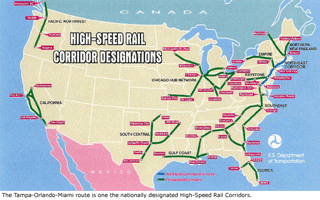
Eleven federally designated high-speed rail corridors have been in the works for years, but funding for the projects was not available until now. (Courtesy of the U.S. House of Representatives)
GELLERMAN: From the Jennifer and Ted Stanley Studios in Somerville, Massachusetts - this is Living on Earth. I’m Bruce Gellerman, in for Steve Curwood.
Ridership on the nation’s mass transit systems; subways, buses and light rails, is at an all time high. But while the mass is up – transit, the number of stops and services is dropping dramatically, even while ticket prices are taking a hike. The federal stimulus package will infuse a massive 16 billion dollars into public transit, half of that for high speed rails.
And William Millar, President of the American Public Transportation Association says, the money is arriving right on time.
MILLAR: Well we like to say it’s the best of times and worst of times, as that famous writer once said. In – since that – in 2007 we had reached a modern high of about 10.3 billion times that year Americans used public transit, only to be eclipsed in 2008. Looks like there’ll be at least five percent higher than that.
GELLERMAN: The costs are spiraling out of control. I was looking at St. Louis and they’re gonna have to eliminate 2000 bus stops because they just can’t afford to run buses there.
MILLAR: In most cases the revenue is not able to keep up with the cost. While people think of paying their fare let’s say when they get on the subway line, that fare is designed to only cover perhaps a third, maybe half the cost of the system. The rest comes from a combination of federal, state and local funds, and those funds come from the very sources that we’re seeing the down turn in the economy. So, sales taxes is a frequent way that it happens or property taxes, and, of course, property values are falling throughout the country. Sometimes gasoline taxes, but, of course, we’re using less gasoline than we did. So at the very time we ought to be increasing our public transit use to meet the new demand, we’re finding that many transit systems around the country are having to cut back, having to raise fares, because, of course, we have to balance our budgets just like everyone else does.
GELLERMAN: How do other countries fund their public transportation systems?

Money from the economic stimulus plan will make more fuel-efficient buses
available to many cities. (The U.S. Department of Transportation Federal Highway Administration.)
MILLAR: In many parts of the world, the national government sets aside a budget for public transportation. You know, in many parts of the developed world the price of a gallon of gasoline is very heavily taxed. Two, three four dollars a gallon is not uncommon. Course in the U.S. the federal tax on gasoline is 18 cents, and the average among the states is maybe an additional 25 or 30 cents on top of that. So we make it very cheap to drive in this country, and, as a result, we don’t raise enough money to keep our roads and our bridges up to snuff. And we don’t raise enough money to fund our public transit systems as well as they should be either.
GELLERMAN: So this 8.4 billion dollars in stimulus money for mass transit, is that going for new stuff or is it going to help commuters pay for their ride?
MILLAR: For the most part it will not be going for what we would call operating expenses which is what the fares help offset. It will be going to replace old buses with new energy efficient buses, which of course, will save money in the long run, as well as be good for the environment and our energy conservation efforts. It will also be used to expand some systems where that’s possible, perhaps new streetcar systems, new bus systems. So it will go for many good things, but unfortunately the Congress did not see fit to make the money available to help cover normal operating expenses.
GELLERMAN: So 8.4 billion dollars for mass transit. Eight billion dollars more for high-speed rail. Where is that going?

Eleven federally designated high-speed rail corridors have been in the works for years, but funding for the projects was not available until now. (Courtesy of the U.S. House of Representatives)
MILLAR: Well, a number of years ago, the Congress designated eleven different corridors around the country for high-speed rail. Some are well known, such as the Northeast Corridor between Washington and Boston, say. Some are less well known, the Cascadia Corridor up in the Great Northwest for example. This money will allow for major improvements in some of those corridors. I certainly predict that if we’re able to try high-speed rail in at least a couple of the corridors and more and more Americans see the advantage of high-speed rail that that will start a revolution akin to what we did with the interstate highway system way back in the 50s when people began to sample what a really good road could mean. Well the same thing with public transit and with intercity rail, high speed rail. Certainly that’s one of the great things about the stimulus package, you can not only create many, many, many thousands of jobs, but we can also move our infrastructure ahead and modernize it, and I think we get a real two-fer when we’re able to do that.
GELLERMAN: Mass transit is good for the air quality – can you quantify that, though?
MILLAR: The transit use that we already have in America saves over 37 million metric tons of carbon dioxide, for example, every year. That’s as if every household in Washington D.C., New York City, Atlanta, Denver and Los Angeles combined suddenly could give up electricity, for example.
GELLERMAN: Well thank you very much. Really appreciate it Mr. Millar.
MILLAR: It was my pleasure to be with you today.
GELLERMAN: William Millar is president of the American Public Transportation Association.
Related link:
American Public Transportation Association
[MUSIC: Transit: Andrew Bird “Fitz And Dizzyspells” from Noble Beast (Wegawam Music 2009)]
Evolution of Climate Science
GELLERMAN: Two years ago The National Academy of Sciences Research Council issued a report evaluating how well the federal government’s Climate Science Program was doing.
Now, the NRC has issued a new report and this one looks to the future. Professor Chris Justice from the University of Maryland is vice-chair of the committee that wrote the report. And Professor Justice says the focus of climate science research needs to change.
JUSTICE: We identified some areas where we were making very good progress in the natural sciences. We’d been making inadequate progress in looking at the impacts on human wellbeing and societal vulnerabilities. How societies are going to be able to adapt and what we’re going to do to mitigate, and which sectors of society are going to be particularly vulnerable to the changing climate.
GELLERMAN: So the focus is now climate change as a fait accompli. It’s gonna be here and we better get ready for it.
JUSTICE: That’s right, and I think there’s a need and what our report says is that there’s a need for us to start to address the questions that are responsive to the urgent needs of society, and I think that’s echoed around the world as international organizations and national organizations, state level, are all interested in asking what do we do now about climate change. And I think that the science research needs to be done to provide the underpinning to those responses.
GELLERMAN: So what kind of science would you suggest that we might start doing in order to address some of these urgent human needs?
JUSTICE: So we identify some priorities for this interagency program. We think that a re-organizing of the program along the lines of scientific societal issues such as the continued food supply, raising sea levels, fresh water availability, ecosystem management, human health and the impacts on the economy of this country, and, of course, extreme weather events and climate events and disasters.
GELLERMAN: So we really haven’t been looking at these types of critical questions until now?
JUSTICE: I think in terms of some of the underpinning science we’ve been doing that, but we’ve not been very good at communicating how we should respond to those and what needs to be done. There’s been a strong emphasis on the physical science part of research and now there’s time to broaden the program a little bit to include the human dimensions.
GELLERMAN: This stuff doesn’t come cheap. I know that just a few days ago, the United States lost a satellite to observe carbon from an orbiting satellite. It was 273 million dollars.
JUSTICE: Yes, that was an extremely unfortunate event, and a lot of people had spent a large amount of time and effort to try and get these instruments built and launched, and that’s a real blow for us. But it does highlight the need for us to look at an international code or cooperation to share data and information from the different observing systems. Luckily there is a Japanese satellite that was launched last month which is addressing some of these observations, and I think now, leaning on that a little bit while we recover from the loss and figure out what we’re gonna do to fill the gap I think is quite important.
GELLERMAN: What kind of money are we talking about in terms of this future research you’re suggesting?
JUSTICE: So, in terms of significant increases of funding we felt that clearly providing the observations needed to see how the climate is changing, to look at the impacts of the change, and for us to monitor those over the long term, that’s a significant cost as you mentioned in the previous comment about the cost of the carbon observatory. We think that regional indicator scale modeling will require a whole new generation of computer infrastructure and a cadre of scientists which have been trained a equipped to work at the regional scale. Funding a national climate service will cost a lot of money. And a comprehensive effort on adaptation mitigation will require new funds. As an academy committee, we didn’t talk about precise dollar amounts, and we get a sense from the program that it’s actually had declining funding since a peak in 1995. So, although the demand for information and the demands on the program are increasing, the budgets have actually declined. And so, we do believe that to build a program that we envision through this report, we’ll need significant increase in funding.
GELLERMAN: How receptive is the current administration to this kind of study?
JUSTICE: Well, we’re hopeful that the current administration will play an active role in guiding and supporting this kind of initiative. We’ve heard repeatedly that they’re interested in supporting a combination of both basic research and mission-oriented research. The administration has been supportive of doing research, and I think now the movement is toward action, what do we do about it, and so the question is, what can be done now and what role does the science play. And so we believe that there’s a need for research to understand the basic processes, but also to address the questions that society are asking as to what do we do now about climate change.
GELLERMAN: Well Professor Justice, I want to thank you very much.
JUSTICE: Thank you very much indeed too.
GELLERMAN: Chris Justice is a professor of geography at the University of Maryland and vice-chair of the National Research Council panel, which just released the report “Restructuring Federal Climate Research to Meet the Challenges of Climate Change”.
Related links:
- Click here for the complete report "Restructuring Federal Climate Research to Meet the Challenges of Climate Change"
- National Research Council
[MUSIC: Pops Mohamed “Kalamazoo” from How Far Have We Come (Melt 2000 1997)]
GELLERMAN: You can hear our program any time on our website, or get a download for your MP3 player. The address is loe.org, that’s loe.org. There you’ll also find pictures and more information about our stories. And we’d like to hear from you. You can reach us at comments@loe.org, once again comments@loe.org. Our postal address is 20 Holland St, Somerville, MA 02144. And you can call our listener line at 800-218-9988. That’s 800-218-9988.
GELLERMAN: Just ahead: bad vibes about the smart grid.
PATAKI: Tell someone you’re going to run wires through their community that come from one state to another state? You don’t have to take a poll. No one is gonna be for it! What is missing is the ability of those who desire to build this transmission system to actually get approval and the permit to do it. It takes years, it takes hundreds of millions of dollars and at best the answer is uncertain.
GELLERMAN: Keep listening to Living on Earth!
[CUTAWAY MUSIC: Geoff Keezer: “Arana Amarilla” from Aurea (Artist Share Records 2009)]
Greening the Grid
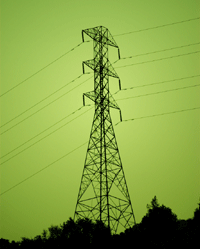
(Photo: Stephen Migol)
GELLERMAN: It’s Living on Earth, I’m Bruce Gellerman.
[SOUND FROM CONGRESS “MADAME SPEAKER, THE PRESIDENT OF THE UNITED STATES” APPLAUSE.]
GELLERMAN: It wasn’t officially a State of the Union address. But President Barack
Obama’s first speech to Congress had all the trappings and high expectations of one as he laid out his plan to jumpstart the stalled economy.
OBAMA: It begins with energy.
GELLERMAN: Energy is so important to President Obama’s plans for the future of the nation he put it at the very top of his speech. And he challenged lawmakers to top their agenda with limits on the green house gases from burning fossil fuels.
OBAMA: So I ask this Congress to send me legislation that places a market-based cap on carbon pollution and drives the production of more renewable energy in America. [Applause] That’s what we need. [Applause.]
GELLERMAN: Selling credits for carbon emissions would be a new source of revenue for the federal government, raising as much as 300 billion dollars a year. Money that would be used for tax cuts and re-tooling the energy economy including thousands of miles of new high-tension power lines. But Living on Earth’s Jeff Young says there are some high hurdles to building a greener grid.
YOUNG: Senate majority leader Harry Reid, the Democrat from Nevada, drew a high-power crowd to his clean energy summit at Washington’s gleaming Newseum Building.
President Bill Clinton took the seat next to Reid and House Speaker Nancy
Pelosi settled in nearby. Legendary oilman turned wind power advocate T. Boone Pickens found himself sandwiched between two Nobel laureates—Al Gore and new energy secretary Steven Chu.
PICKENS: I hope there is a camera here and has me between the two Nobel leaders. It would be very exciting if my mother was still alive to see that. [Laughter]
YOUNG: Moderator Tim Wirth, former Colorado senator, hopes the assembled star power will put the spotlight on an otherwise low wattage issue: the nation’s electric grid.
WIRTH: As I would call it one of the most anesthetizing issues there is. If you ask a constituency what do they think about the grid they go blank right away and move on to the next question.
YOUNG: The two dozen panelists piled on the reasons people concerned about climate and energy should be thinking about the grid. In short, it’s the missing link in the path to a clean energy future. Some called for an electron superhighway, much the same way we once built an interstate highway system. Massachusetts democratic representative Ed Markey likened it to early efforts to electrify the country.
MARKEY: Back in the 1930s, urban America decided they were going to fund construction of electric lines to bring it out to rural America. Now we have to decide how to get it in from the prairies into the cities.
YOUNG: It will not be easy or cheap. The recently passed economic stimulus bill includes 11 billion dollars in support for grid improvements and expansion. That figure’s dwarfed by cost estimates for new lines that would link the Great Plains to cities in the Midwest and Northeast.
But money might not be the biggest obstacle. New transmission lines run into a briar patch of siting and permitting problems. High voltage lines can cut through scenery and carve up sensitive habitat. Landowners fear lost property value, and local governments fear getting saddled with costs for projects that don’t benefit them. Former New York Republican Governor George Pataki offered the panel a reality check.
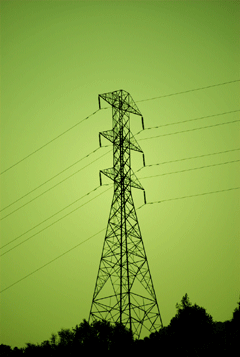
(Photo: Stephen Migol)
PATAKI: Tell someone you’re going to run wires through their community that come from one state and run through to another state? You don’t have to take a poll. No one is gonna be for it! What is missing is the ability of those who desire to build this transmission system to actually get approval and the permit to do it. It takes years, it takes hundreds of millions of dollars, and at best the outcome is uncertain.
YOUNG: Even when the purported goal is to carry clean energy, power lines can still end up generating controversy. Case in point: a line called Sunrise Powerlink. It’s supposed to link San Diego to new solar generation planned in the desert to the east. A natural way to win support from eco-conscious Californians, right? Wrong.
ZICHELLA: It’s a poster child for how to do a transmission line wrong.
YOUNG: That’s Sierra Club’s Carl Zichella. He says the 150-mile line would threaten desert habitat with few assurances that it would really carry solar power. A natural gas facility lies nearby to the south. The Sunrise project got preliminary approval from the state but now faces legal challenges from environmental groups.
Zichella’s been fighting that and other power line proposals for years. But he recently joined a coalition of renewable energy advocates and businesses who want to find a way they can support new power lines.
ZICHELLA: For folks that have been advocating for renewable energy for years as a solution to the climate crisis you can’t love renewable energy if you don’t like transmission. And we’re gonna have to learn to like transmission. And the only way we’ll learn to like it is by putting it in the right places.
YOUNG: Zichella says those who want new lines have to learn from past mistakes. They should include more people in the planning process and guarantee those new lines will really carry clean energy.
John Podesta says the key to resolving these issues is to start thinking big. Podesta’s a power player in Washington these days. He led then President-elect Obama’s transition team. And Podesta’s think tank, the Center for American Progress, helped Senator Reid organize the energy summit.
PODESTA: What’s happened is people understand energy is a national problem that needs a national solution. And I think that what is gonna be essential is that state sensibilities are taken into account. But it has to feed into a national system. If we had had the same attitude in 1950s about every road needs to be only thought about by local communities we’d have never built the interstate highway system.
YOUNG: Podesta calls the current patchwork of state regulations “byzantine, balkanized and broken.”
But state officials are leery of a federal approach that would put them on the sidelines. Fred Butler directs the National Association of Regulated Utility Commissioners. The commissioners oppose more federal control. But Butler can also read the writing on the political wall and says his group is reconsidering.
BUTLER: We kind of see this movement gaining some momentum and we want to be at the table to discuss it. So if our position is no, no, no, a thousand times no, then we kind of feel that we might not be part of the discussion.
YOUNG: One thing is sure: All these tough questions about how to best plan, permit and pay for clean energy transmission will no longer be in the political shadows. They’ll be front and center as congress considers a bill by Senator Reid that would give the federal government a greater role.
REID: You should be aware that what we’re talking about doing is making it possible for this energy that we’re creating all over the United States to take it where it’s needed. But we’re going to move beyond – and that’s part of the conversation today – one state being able to hold up forever something that needs to be done for the rest of the country.
YOUNG: And as for concerns from state officials, well, Reid, a former boxer, made it clear he’s ready to flex some muscle.
REID: Whatever we pass at the federal level trumps all that. Okay?
YOUNG: Reid’s proposal is winning early support from clean energy advocates, who call it a nice balance of state and local input and federal authority to get projects done. But it could still be a tough sell on Capitol Hill where lawmakers want to make sure their voters back home still have some power over power line decisions.
For Living on Earth, I’m Jeff Young in Washington.
Related links:
- Read the Energy Future Coalition’s ideas for the grid
- View a webcast of Sen. Reid’s Clean Energy Summit
[MUSIC: Sofa Surfers “Beans And Rice” (Mad Professor Dub) from Constructions (Klein records 2007]
Water Footprinting
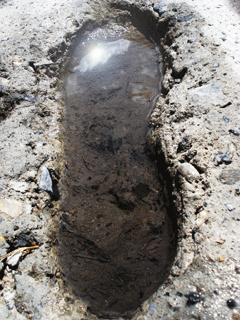
GELLERMAN: The next time you’re shopping for a pair of leather shoes - consider this: it took 21 hundred gallons of water to produce them.
21 hundred gallons for one pair of shoes - that’s the shoes’ water footprint. A water footprint is a new way of looking at the economic costs and environmental impacts of water in the everyday things we use.
Derk Kuiper is Executive Director of the Water Footprint Network in the Netherlands.
KUIPER: What this number tells you is basically not only direct use from the tap, but it’s also the indirect use that you have through consumer products or producing those products, and you can actually start understanding the amount of water you’re shipping around the world.
GELLERMAN: Lemme get my water footprint for some common products, okay?
KUIPER: Yeah.
GELLERMAN: How about making a hamburger? How much water goes into making a hamburger?
KUIPER: It’s about sort of 2.7 thousand liters of water that goes in there.
GELLERMAN: That’s about what – 630 gallons of water for one hamburger.
KUIPER: Yeah.
GELLERMAN: How about a glass of beer?
KUIPER: A glass of beer is basically 75 liters of water, well you’re obviously not drinking that physically, but at least the water has been used in the production of, for example, the hops and wheat that is being used for brewing the beer.
GELLERMAN: Seventy-five liters, that’s about 20 gallons.
KUIPER: Yes.
GELLERMAN: So the idea is that like a carbon footprint has a certain impact on the planet, then your water footprint has a similar impact.
KUIPER: Yeah, there’s one complicating factor with water is the carbon is basically pooled in the atmosphere and water is very locally based, so the impacts of your water footprint are actually quite diverse. So, for example, if you look at water rich regions like the Amazon area, the impact of your water use there might be far less than for example in a water scarce area in eastern Africa. So, you need to have a very specific measure of the localized impacts and that complicates matters.
GELLERMAN: Ah, so when you’re talking footprint, you’re actually talking impression in a local area.
KUIPER: In the end you will do that, but the question is at this point, we cannot yet do that. We are developing that and that’s also why we have the Water Footprint Network. We want to develop that methodology further to actually start understanding what the volume that you have to have in your water footprint is actually having for an impact in a local situation.
GELLERMAN: Well the idea of a water footprint is, I understand, is becoming more and more popular in the business world. They’re actually starting to consider how much water they’re using in producing the products they produce.
KUIPER: You know, in light of their sort of corporate citizenship and stewardship, the best way to understand how the impact on the world. And there’s not only impact on the natural environment, also people. And water is one of those sort of key topics now after climate change, because some of the stress on water resources in areas like, for example, Pakistan and so on, is huge, and they need to do something about it. Because otherwise they might actually run great, not only reputational risk, but also fiscal risks in terms of having their supply chains falling apart.

KUIPER: Thank you very much.
GELLERMAN: Derk Kuiper of the Water Footprint Network
About 90 percent of the water used each year in developing countries goes to agriculture. Crops like cotton are notoriously thirsty - so things made from cotton – say blue jeans - have a large water footprint.
How large? The answer from Michael Kobori, vice president at Levi-Strauss & Company, might surprise you.
KOBORI: It takes 919 gallons of water to produce a pair of our flagship product, which is, as I’m sure you know, Levis 501s.
GELLERMAN: Those are the ones with the buttons, no zipper.
KOBORI: That’s correct.
GELLERMAN: Nine hundred and nineteen gallons for one pair of jeans?
KOBORI: Yes, and I should explain how we arrived at that figure. A few years ago what we did was a product life cycle assessment. So from the raw materials, growing the cotton, through manufacturing, distribution, consuming use and final disposal.
GELLERMAN: So what does that make your water footprint?
KOBORI: So, what this means for us, Bruce, as we look at the break down here. We actually didn’t focus on the cotton or the consumer immediately. What we did was we focused on the little less than six percent that we actually control in our manufacturing of the product. And the largest amount of that is taken up in the industrial laundries around the world that wash the product to get the different finishes that you see on the pair of 501s. So we took a look at the quality of that water and the nice things that’s happened is as those laundries have constructed these treatment facilities, what that’s enabled them to do is actually in most cases recycle more of the water so their actual use of the water has dropped. So in some cases the laundries are able to recycle seventy to eighty percent of the water. So as the cost of water begins to increase in a number of countries around the world, just because water is becoming more of a scarce commodity, having treatment facilities, having the recycling programs has enabled our suppliers to avoid paying increased fees in some cases, both for water and for the disposal of the discharge of the water. In some of our laundries, they’re saving up to a $100,000 a year.
GELLERMAN: Water’s going to be scarcer still when global warming hits full bloom. What are you planning to do there in the future?
KOBORI: Well, so in the future, we’re starting to look at the bigger sections of that life cycle. So the cotton and the consumer use. And we’ve been working with experts as well as others in the industry to understand the water impact of cotton better, and what we can do about it. We know we need to do something, even if we don’t directly buy the cotton, we work with fabric mills that purchase the cotton, so we’ve trying to figure out what can we do around supporting more sustainable cotton.
GELLERMAN: Well what can I do? I mean, I’m wearing a pair of your jeans right now.
KOBORI: What you can do is wash less. What we’ve done is begun to change the way we communicate to our consumers about their care of the product. So with what we call our eco product, which is this product that is made out of recycled denim or organic cotton, we’ve changed the label on the product to say to consumers “wash only when necessary in cold water and line dry if possible.” It’s better for your jeans and its better for the environment.
GELLERMAN: Well Mr. Kobori, thank you very much.
KOBORI: You’re very welcome, Bruce.
GELLERMAN: Michael Kobori is a Vice President of Supply Chain Social and Environmental Sustainability at Levi-Strauss.
Related links:
- Ceres has released a report detailing the impacts of climate change on global water supplies
- Water Footprint Network
- Representatives from major corporations around the world met recently in Miami to talk about water footprinting and business.
[MUSIC: Abdullah Ibrahim “Moniebah” from Good News From Africa (Enja records 1973)]
Thoreau in the ‘Burbs
GELLERMAN: There are some who find inspiration in Henry David Thoreau, the 19th century naturalist, poet and tax resister who headed to the woods and lived the solitary life chronicled in his book Walden.
Then there are folks like Commentator Tom Montgomery-Fate
MONTGOMERY-FATE: Walden is an inspiring book. Yet now when I read it I find myself looking for what Henry doesn’t say, for what’s missing. He must have felt more loneliness than he commits to ink.
This morning I tracked down the one exception, the one weak moment I remember in the book.
“I have never felt lonesome, or at least oppressed by a sense of solitude,” he writes. “But once, and that was a few weeks after I came to the woods, when, for an hour, I doubted if the near neighborhood of man was not essential to a serene and healthy life.”
Only one hour of loneliness in his two years at the cabin? Unlikely. But maybe it doesn’t matter, since it’s his recovery from this rare instance of loneliness that readers remember.
That day amid a gentle rain Henry suddenly recognizes “the beneficent society of Nature”: “Every little pine needle expanded and swelled with sympathy and befriended me,” he writes. “I was so aware of the presence of something kindred to me, even in scenes which we are accustomed to call wild and dreary…that I thought no place could ever be strange to me again.”
Today I can’t help but wonder if Thoreau would find my home in suburban Chicago a bit strange and dreary, even lonely. I would love to read the book he would write here in Glen Ellyn, particularly if he were married with three kids. I suppose he would call it “Glen Ellyn, or Life in the Burbs.”
And though I’m admittedly fishing for points of connection where they don’t exist, I do wonder how marriage and children would have affected Thoreau’s otherwise “deliberate” life—if they would have restrained or liberated him and made him more or less lonely.
Perhaps he would start that famous passage differently: I got married and had children “because I wished to live deliberately, to front only the essential facts of life, and see if I could not learn what it had to teach, and not, when I came to die, discover that I had not lived.”
I wonder how Henry would have negotiated a much different kind of wilderness—how he would “simplify” the deep compromises that marriage and parenting require. Or how his fierce commitment to leisure and solitude would endure his children’s late night sickness, or his partner’s request for him to get a job. Would his immense patience and listening in the woods translate to the family dinner table?
But these are probably not fair questions. Marriage and children were just not part of the life he chose. And in my longing to find Thoreau’s hidden loneliness perhaps I’m missing the point of the book. Which is not to retreat to a cabin in the wilds, but to find the wildness within, to learn to be “at home” in self and world, no matter where you live.
GELLERMAN: Tom Montgomery-Fate teaches writing at College of DuPage in Glen Ellyn, IL and is the author of “Steady and Trembling: Art, Faith, and Family in an Uncertain World.”
Related links:
- Tom Montgomery-Fate
- Other writings by Tom Montgomery Fate
[MUSIC: Nels Cline “Nomad’s Home” from Coward (Cryptogramophone 2009)]
GELLERMAN: Just ahead: - Oy, do we have a story for you. Stay tuned to Living on Earth.
ANNOUNCER: Support for the Environmental Health Desk at Living on Earth comes from the Cedar Tree Foundation. Support also comes from the Richard and Rhoda Goldman fund for coverage of population and the environment. And from Gilman Ordway for coverage of conservation and environmental change. This is Living on Earth on PRI, Public Radio International.
[CUTAWAY MUSIC: Steve Cropper – Felix Cavaliere “Jamaica Delight” from Nudge It Up A Notch (Concord Music 2008)]
Coco Trash to Coco Cash
GELLERMAN: It's Living on Earth, I'm Bruce Gellerman.
Coming up– using the salt of the earth to clean the planet - but first this note on emerging science from Liz Gross.
[MUSIC: The Hit Crew “Coconut (Put The Lime In The Coconut) from Berry Special Party Music (TUTM Entertainment 2008)]
GROSS: Many a song has been inspired by the inside of a coconut – the sweet milk and the snow white meat. But what about the outside? The fibrous husk, which accounts for more than a third of the mass of a coconut, is often thrown away. But now, engineers have found a way to turn this coconut trash into cash.
[THEME]
GROSS: Researchers at Baylor University in Texas have come up with a method to mold fibers from coconut husks into car parts, including trunk liners, floorboards and interior door covers. The coconut fibers are just as strong as the synthetic polyester currently used for the production of these parts, but have some added benefits for farmers, manufacturers, and the environment.
Coconuts are a renewable resource, abundant in countries all around the equator, including India, the Philippines, Brazil and Indonesia. Almost all of the 50 billion coconuts grown every year come from small farmers, who earn, on average, less than two dollars a day. Using the discarded husks to make car parts increases the value of each coconut. The research team hopes that increasing demand could allow coconut farmers to triple their incomes.
Meanwhile, the price of the car parts stays the same, or lower, than it was before. If the auto companies can be sold on the idea, we may be singing the praises of the whole coconut – from inside to out…
That’s this week’s note on emerging science, I’m Liz Gross.
Magic Water
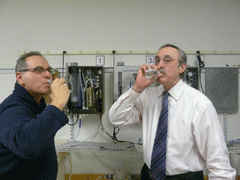
Bruce Gellerman (left) and Patrick Lucci toast to electrolyzed water. (Photo: Liz Gross)
GELLERMAN: In Russia they pour it down oil wells to kill trouble-making microbes.
In New Mexico it’s used to neutralize germs in the guts of cows - and in Japan, it disinfects taxicabs.
IT is electrolyzed water - salt water that’s been zapped with electricity and turned into powerful - but safe - detergent and disinfectant.
The Electrolyzer Corporation of Woburn Massachusetts makes the machines that make the water. Patrick Lucci is Vice President of Marketing.
LUCCI: An electrolyzer is a device that basically makes two solutions out of salt water and electricity. One solution is a sanitizer that at 50 parts per million is more effective than chlorine bleach at 200 parts per million, yet it’s so non-toxic you can drink it. The other is a form of sodium hydroxide that’s used as a detergent for floors, carpets or anything else you would wash.
GELLERMAN: Magic water.
LUCCI: I don’t like to call it magic water, but a lot of people do.
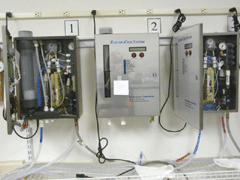
The electrolyzer. (Photo: Liz Gross)
GELLERMAN: So take me through the process. How do you create something out of water that has such powerful properties that it can be both a disinfectant and a cleaner?
LUCCI: Let me take you in the lab, and I’ll show you.
GELLERMAN: Okay.
[FOOT STEPS]
LUCCI: It’s a fairly simple process. It’s something that you probably learned in your high school chemistry class, but forgot. So here is an electrolyzer.
[MACHINE SOUNDS]
LUCCI: There is a positive electrical charge in this left chamber, a negative electrical charge in the right chamber. Now these two chambers are lined with ion permeable membranes, and they’re smart membranes. The ones that line this left-hand chamber only allows the migration of chloride ions into the chamber. The chloride ion is negatively charged in nature. When it hits the positive electrical charge here, it’s electrochemically converted from Cl to HOCl, which is hypochlorous acid.
GELLERMAN: Cl is …?
LUCCI: Chloride.
GELLERMAN: And hypochloric acid?
LUCCI: Hypochlorous acid, HOCl.
GELLERMAN: And what is hypochlorous acid?
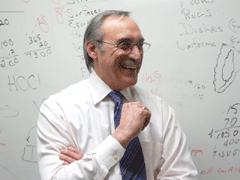
Patrick Lucci. (Photo: Liz Gross)
LUCCI: Hypochlorous acid is an antibacterial solution. It’s extraordinarily efficient, extraordinarily powerful. Now in the right chamber there is a negative electrical charge. The sodium ion is the only ion allowed in there by the ion permeable membrane. The negative electrical charge attracts the positively charged …
GELLERMAN: It’s been a while since high school, and Pat Lucci’s right, I did forget my basic chemistry. He gave me a remedial lesson on a white board.
LUCCI: So basically what we have is we have two chambers …
[SCREECHING OF MARKERS ON A WHITE BOARD]
LUCCI: … and we’ve got salt water.
[SCREECHING OF MARKERS ON A WHITE BOARD AND THE SOUND OF RUNNING WATER]
LUCCI: And we’re taking the salt water, and we got a positive charge here, negative charge here. We’re putting tap water into the chambers. As we’re pumping the salt water through in between these chambers, the chloride ions migrating into here and the sodium ions are migrating here. When the chloride ion hits the positive electrical charge, it’s electrochemically converted to HOCl, and it exits the chamber into a storage tank. The sodium is zapped with a negative electrical charge, because it’s positive, and it exits as sodium hydroxide, NaOH. Simple as that.
GELLERMAN: So basically what you’re doing is you’re taking a salt water and splitting it.
LUCCI: We’re splitting the salt. The hypochlorous acid is a sanitizer; the sodium hydroxide is a cleaner. Sodium hydroxide is a basic element in just about every soap and detergent out in the market. It’s a grease cutter.
GELLERMAN: How good a grease cutter?
LUCCI: Depends on the concentration. In the concentrations that we make which are about 166 parts per million, it’s good enough to clean a floor – if you heat it – it’s good enough to clean a floor without soap and it’s good enough to clean a rug without soap. It’s also good enough to clean dishes without soap. And we’ve proven that in every hotel that we’ve install units in.
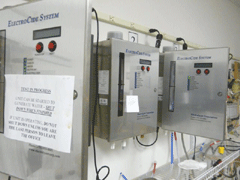
The electrolyzer. (Photo: Liz Gross)
GELLERMAN: So what you sell is these units, these boxes.
LUCCI: Yeah. We sell the box.
GELLERMAN: Well what are the benefits of this stuff as compare to the, you know, Mr. Clean?
LUCCI: A lot. First of all, according to the Environmental Protection Agency 27,000 hotel workers every year are harmed by harmful chemicals. We make that go away. We take away all of the bleach, all the quaternary ammonia, all the detergents. Hotel workers have less sick time, fewer injuries because of chemicals and the hotel management saves on all of those workers compensation cases. Those are the primary benefits. The other benefits are cost. We make these two solutions at the cost of roughly a penny a gallon, which is significantly less than the cost of the chemicals they use. So an operation like for example the Royal Sonesta in Cambridge Massachusetts, they’re saving $500 a month just in housekeeping. And the machine pays for itself in actually under a year. When we bring the dishwashing application online they will save an additional $10,000 a year on dishwashing detergent.
GELLERMAN: Now the disinfectant, that’s called …?
LUCCI: Hypochlorous acid.
GELLERMAN: And how does that work? Why is it so powerful?
LUCCI: Hypochlorous acid is a form of chlorine that exhibits zero cytotoxicity. That means that it is harmless to human and animal cells. However, it is highly reactive with proteinaceous material.
GELLERMAN: So if you had a virus from influenza, it would kill it?
LUCCI: Yes. It does kill the influenza virus very effectively.
GELLERMAN: Anthrax bacilli?

Bruce Gellerman (left) and Patrick Lucci toast to electrolyzed water. (Photo: Liz Gross)
LUCCI: Anthrax is a bacteria, but it kills it, yes. It also kills HIV.
GELLERMAN: Now, and it’s harmless to me. Can I take a swig?
LUCCI: Yep.
GELLERMAN: Really?
LUCCI: Yeah.
GELLERMAN: Could you take a swig?
LUCCI: Watch me. I’ve done it. I’ve done it many times.
[SOUNDS OF LAB GLASSWARE]
LUCCI: Alright, the first thing I’m going to do is I’m gonna prove to you - by emptying some of this solution into a cup – I’m going to prove to you that there’s chlorine in there. These test strips measure free chlorine.
[SLOSHING SOUNDS]
LUCCI: So I’m going to take a test strip out of the bottle. I’m gonna wave it around in this little cup full of water.
GELLERMAN: And – voila – it turns blue.
LUCCI: And as you can see we are looking at somewhere around 50 parts per million in free chlorine.
GELLERMAN: Does it smell?
LUCCI: Sure does.
GELLERMAN: Oh yeah, it’s got that kind of swimming pool smell.
LUCCI: Yeah.
[SOUNDS OF DRINKING: “AHHH”]
LUCCI: Betcha wouldn’t do that with bleach.
GELLERMAN: You’re not gonna keel over later.
LUCCI: Not any time soon. The biggest down side to drinking this is that if you do it regularly or in large volumes you’ll create an imbalance between the good bacteria and bad bacteria in your body and get some sort of an infection.
GELLERMAN: But what happens if you had like food poisoning? Could you take this? Would it kill the food poisoning?
LUCCI: No, by the time you have food poisoning it’s too late. But treating your food products with the water helps to avoid food poisoning.
GELLERMAN: So you could spray this on….
LUCCI: Spray it on – oh absolutely. As a matter of fact, one of the biggest applications in Japan is spraying this on sushi. But it’s very – it’s a great hand sanitizer. If you put some on your hands and rub it around on your hands and let it dry, right now, you’ll have a fine hint of chlorine.
GELLERMAN: Uh huh.
LUCCI: As soon as that dries, you won’t smell the chlorine any more and the reason is hypochlorous acid wants to be a gas. So as the water evaporates, the hypochlorous acid goes off into the air, so there’s no residue. So you put this on fruits and vegetables, you’ll a) make them safer to eat, and b) you’ll extend their shelf life because you’ll kill all the bacteria.
GELLERMAN: So what am I missing about this process?
LUCCI: I don’t think you’re missing anything. I think you’re getting it.
GELLERMAN: Well, Mr. Lucci, thank you very much.
LUCCI: Well, thank you very much. It was great for you to come over and I’m glad we gave you a little science lesson.
GELLERMAN: Pat Lucci, Vice President of Marketing at Electrolyzer Corporation in Woburn, Massachusetts, hopes to clean up with their machines, which make electrolyzed water. There are drawbacks right now, the machines are too pricey for the average home and the stuff loses its potency fairly quickly, so it can’t be stored for long.
[MUSIC: Thunderball “Solar” from Scorpio Rising (Eighteenth Street Lounge 2001)]
Green Mitzvah
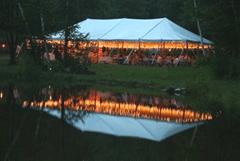
The solar-powered setting. (Photo: Charles Kozierok)
GELLERMAN: These days it seems everything is going green: green cars, green homes, green energy and –oy, Green Bar Mitzvahs?
[MUSIC: “HAVA NAGILAH…”]
GELLERMAN: According to Jewish tradition a bar mitzvah marks a child’s rite of passage into adulthood.
The ceremony is a solemn affair - but afterwards—there are often blow out parties with tons of food, and Meshugana themes.
You can have a James Bond bar mitzvah - Vegas casino bar mitzvahs - even an oxygen bar…bar mitzvah.
Now, there’s a small but growing, sustainable bar mitzvah movement.
Kate Harrison operates greenbarmitzvahs.com. Kate, shalom!
HARRISON: Thanks so much for having me.
GELLERMAN: So give me some examples. How do you make a green bar mitzvah?
HARRISON: Well, you mentioned the food – oy, right?
[LAUGHING]
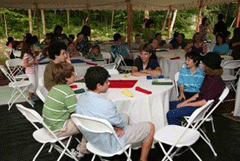
Brendan waits with friends for food to be served on compostable plates. (Photo: Charles Kozierok)
HARRISON: Every bar mitzvah has food, this huge celebration – food is really at the center of the Jewish life. And by choosing local foods, seasonal foods, organic foods you can have all the things you’re used to having, but in a green way, a way that doesn’t harm the earth.
GELLERMAN: But you still get to have a lot of food.
HARRISON: Oh yeah. You can have tons of food. And leftovers are fine. Send them home in boxes made from recycled cardboard.
GELLERMAN: I was looking at your website and some people came up with center pieces with can goods that they would then donate to a food pantry. What a great idea.
HARRISON: Yeah. I love this idea. And some of the sculptures that you can make out of canned goods are really beautiful.
GELLERMAN: Can-ny Youngman [Laughing]
HARRISON: Yeah. [Laughing] And it doesn’t have to just be can goods. I saw another one – someone wrote in about where they used stuff animals, but just the idea that you’re – instead of just using flowers for your center piece that you have something that you can then donate to the community or use for change or good.
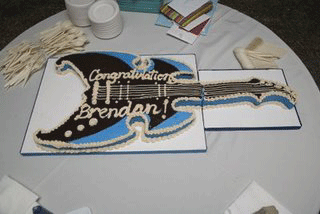
(Photo: Charles Kozierok)
GELLERMAN: Is there any part of the Jewish religion or heritage that’s green, that’s the basis of this?
HARRISON: Well the relationship between Jews and the environment goes back over 7,000 years, from the kashrut movement to stewardship of the earth type language in the Talmud and in the Torah.
GELLERMAN: Kashrut means kosher.
HARRISON: Yeah, kashrut is a whole system of laws about how to tend for animals and also the earth. So, for example, the organic movement and the kashrut movement overlap in that every seven years in Judaism you have to let the land fallow. And the idea of that is that the land needs to replenish itself and build up its nutrient base. And that really ties into the idea of the organic food movement where it’s all about soil fertility. So, these modern ideas really have a basis in ancient tradition.
GELLERMAN: Here’s one I really liked – a hemp kippur, that’s a yarmulke, skull cap you wear.
HARRISON: So hemp kippot are really fun. But one of my favorite ecofriendly Jewish focused elements that I’ve seen are these eco-suede kippot. And they’re actually made out of a recycled cardboard, but they’re very soft and they’re recycled. So most kippot are made out of sort of a velvet or a petroleum base, where eco-suede kippot or hemp kippot or silk kippot are all made out of sustainable materials.
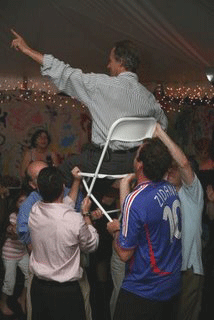
Brendan’s father lifted in a chair. (Photo: Courtesy of Kate Harrison)
GELLERMAN: I gotta tell you, Kate, the yarmulkes that I have are all recycled, they all come from somebody else’s bar mitzvah.
[LAUGHING]
HARRISON: And actually, you know, it’s funny you say that, because recycling is another form of being green. And instead of getting any kind of new kippot or tallis, you can borrow all that stuff.
GELLERMAN: Kate, does going green mean spending, you know, spending more green or can you save money?
HARRISON: This is a myth I’m working really hard to try to dispel that by making green choices you have to spend more. In fact, across the board I’ve found that you can save about forty percent off the cost of any party by going green.
GELLERMAN: Well Kate I want to bring Brendan Eprile into our conversation. He’s in Bennington, Vermont and was recently bar mitzvahed. Brendan, mazel tov!
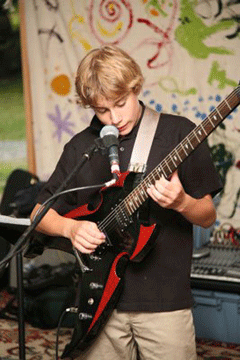
Brendan plays his solar-powered electric guitar at his green Bar Mitzvah. (Photo: Charles Kozierok)
EPRILE: Thank you.
GELLERMAN: So how green was your bar mitzvah?
EPRILE: Well, I don’t know on a scale from one to ten how green it was, but we had cardboard yarmulkes, recyclable. And we had compostable plates and compostable forks and cups made out of corn. And it was in a very green place that had solar power instead of regular power. So, I guess you could say it was green.
HARRISON: It was very green. Brendan was kind enough to let me write about his bar mitzvah on the site and it was a beautiful party and he had a lot of really very cool eco-friendly elements.
GELLERMAN: Brendan, I’m looking at some pictures of your bar mitzvah and is that your dad being lifted up in a chair.
EPRILE: Yeah.
GELLERMAN: So you have a cake in the shape of a guitar – do you play?
EPRILE: Oh yeah, I do play guitar.
GELLERMAN: Anything green about the cake.

The solar-powered setting. (Photo: Charles Kozierok)
EPRILE: Well, not the cake itself. But the guitar itself, when I played it, the amp was run by solar power because every single thing, like the lights, everything, was run by solar power. So I wasn’t causing an impact while I was playing guitar.
GELLERMAN: So how do the guests react to your green bar mitzvah?
EPRILE: Oh I think they liked it, but a lot of people ended up throwing out the plates in the garbage instead of the compost. A lot of people were just really happy about the beautiful setting and stuff.
GELLERMAN: Well, Kate, that brings up an interesting point. I mean, at a bar mitzvah you produce a lot of chazerai, a lot of garbage.
HARRISON: Oh, yeah. You know the average party produces about 600 pounds of waste. I should add that Brendan’s mother told me that she ended up digging through the garbage to pull those plates out and compost them, so… And one of the things that I talk about a lot and try to emphasize is that when you do make green choices like those plates, let guests know about it, because it’s an educational opportunity for them, and also then they won’t throw them away and you won’t have to go dig threw the trash. It can be a lesson. A lesson to us all. [Laughs]
GELLERMAN: Well, Kate, it’s been a lesson for me. Thank you very much.
HARRISON: Oh, thank you.
GELLERMAN: Kate Harrison operates the website greenbarmitzvahs.com.
And Brendan, thank you.
EPRILE: Thank you.
GELLERMAN: And mazel tov again. You’re now a man.
HARRISON: A green man.
EPRILE: Thank you.
GELLERMAN: Brendan Eprile lives in Bennington Vermont and was recently bar mitzvahed.
Related link:
Green Bar Mitzvahs
[MUSIC: Hava Nagila]
GELLERMAN: On the next Living On Earth, coal miners learn to leverage their labor for a better life.
ANDREWS: They understood, you know it was really their labor that made this world go round, and so they understood that by cutting off the flow of energy to the broader society, that that was really the strongest lever that they had to secure what they wanted.
GELLERMAN: Killing for coal. The deadly consequences of a miner’s strike - next time on Living on Earth.
[MUSIC: New Orleans Klezmer All Stars “Klezmer Defiance” from Fresh Out Of The Past (Shanachie Records 2005)]
GELLERMAN: Living on Earth is produced by the World Media Foundation. Our crew includes Ashley Ahearn, Bobby Bascomb, Eileen Bolinsky, Ingrid Lobet, Helen Palmer, Mitra Taj and Jeff Young, with help from Sarah Calkins and Marilyn Govoni. Our interns are Lindsay Breslau, Liz Gross and Christine Parrish. Jeff Turton is our technical director. Alison Lirish Dean composed our themes. You can find us anytime at loe.org. Steve Curwood is our executive producer.
I’m Bruce Gellerman. Thanks for listening.
ANNOUNCER: Funding for Living on Earth comes from the National Science Foundation, supporting coverage of emerging science, and Stonyfield Farm: organic yogurt and smoothies. Stonyfield pays its farmers not to use artificial growth hormones on their cows. Details at stonyfield.com.
Support also comes from you our listeners, the Ford Foundation, the Town Creek Foundation, the Oak Foundation supporting coverage of climate change and marine issues; the Skoll Foundation, supporting social entrepreneurs around the world – uncommon heroes dedicated to the common good. Learn more at skoll.org; and Pax World Mutual Funds: socially and environmentally sustainable investing. Pax World: for tomorrow. On the web at paxworld.com.
ANNOUNCER: PRI, Public Radio International.
Living on Earth wants to hear from you!
Living on Earth
62 Calef Highway, Suite 212
Lee, NH 03861
Telephone: 617-287-4121
E-mail: comments@loe.org
Newsletter [Click here]
Donate to Living on Earth!
Living on Earth is an independent media program and relies entirely on contributions from listeners and institutions supporting public service. Please donate now to preserve an independent environmental voice.
NewsletterLiving on Earth offers a weekly delivery of the show's rundown to your mailbox. Sign up for our newsletter today!
 Sailors For The Sea: Be the change you want to sea.
Sailors For The Sea: Be the change you want to sea.
 The Grantham Foundation for the Protection of the Environment: Committed to protecting and improving the health of the global environment.
The Grantham Foundation for the Protection of the Environment: Committed to protecting and improving the health of the global environment.
 Contribute to Living on Earth and receive, as our gift to you, an archival print of one of Mark Seth Lender's extraordinary wildlife photographs. Follow the link to see Mark's current collection of photographs.
Contribute to Living on Earth and receive, as our gift to you, an archival print of one of Mark Seth Lender's extraordinary wildlife photographs. Follow the link to see Mark's current collection of photographs.
 Buy a signed copy of Mark Seth Lender's book Smeagull the Seagull & support Living on Earth
Buy a signed copy of Mark Seth Lender's book Smeagull the Seagull & support Living on Earth

